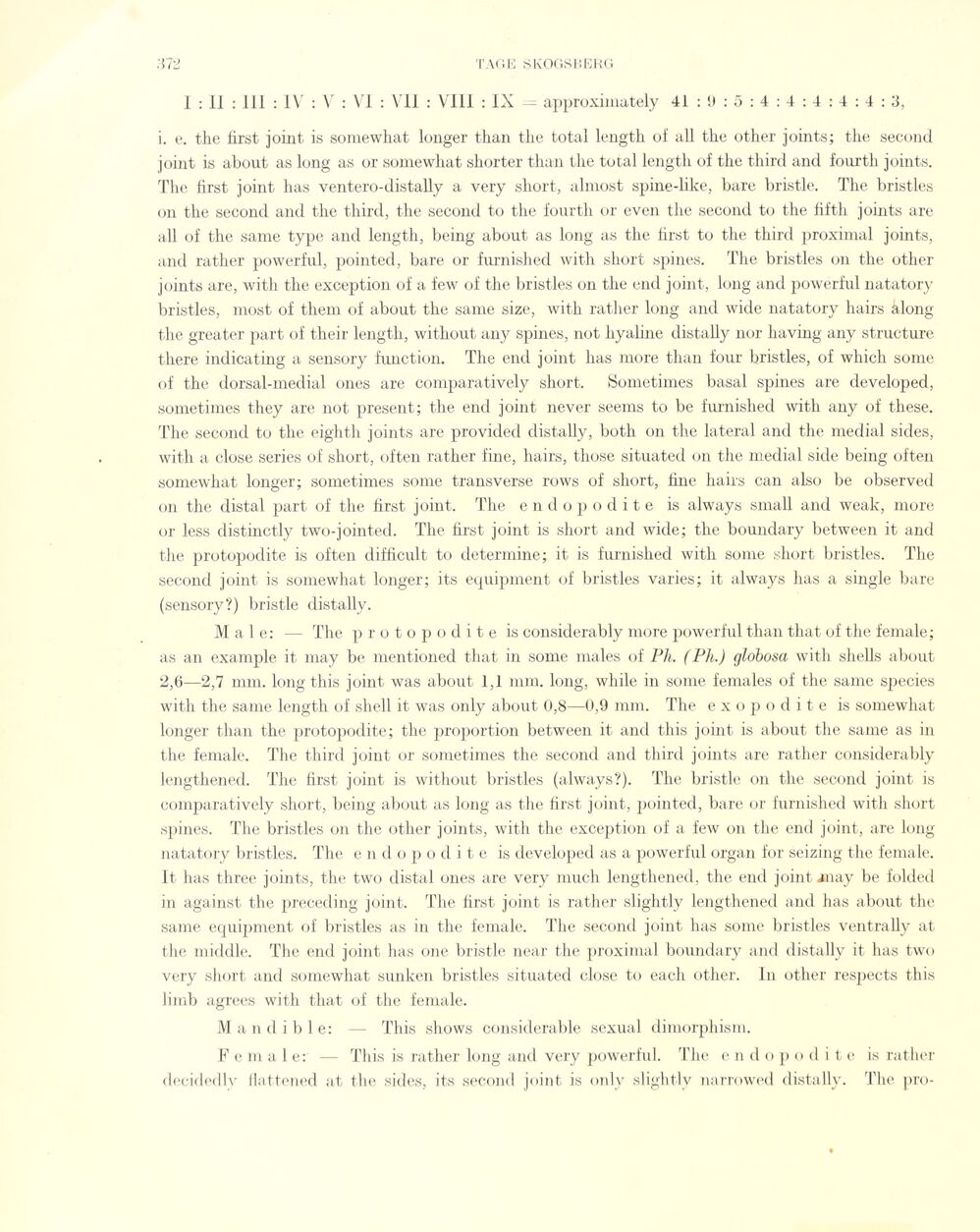
Full resolution (JPEG) - On this page / på denna sida - Sidor ...

<< prev. page << föreg. sida << >> nästa sida >> next page >>
Below is the raw OCR text
from the above scanned image.
Do you see an error? Proofread the page now!
Här nedan syns maskintolkade texten från faksimilbilden ovan.
Ser du något fel? Korrekturläs sidan nu!
This page has never been proofread. / Denna sida har aldrig korrekturlästs.
I : 11 : 111 : IV : V : VI : VU : VIII : IX - approximately 41:9:5:4:4:4:4:4:3,
i. e. the first joint is somewhat longer than the total length of all the other joints; tlie second
joint is about as long as or somewhat shorter tlian the total length of the third and fourth joints.
The first joint has ventero-distally a very short, almost spine-like, bare bristle. The bristles
on the second and the third, the second to the fourth or even the second to the fifth joints are
all of the same type and length, being about as long as the first to the third proximal joints,
and rather powerful, pointed, bare or furn ished with short spines. The bristles on the other
joints are, with the exception of a few of the bristles on the end joint, long and powerful natatory
bristles, most of tliem of about the same size, with rather long and wide natatory hairs ålong
the greater part of their length, without any spines, not hyaline distally nor having any structure
there indicating a sensory function. The end joint has more than four bristles, of which some
of the dorsal-medial ones are comparatively short. Sometimes basal spines are developed,
sometimes they are not present; the end joint never seems to be furn ished with any of these.
The second to the eightli joints are provided distally, both on the lateral and the medial sides,
with a close series of short, often rather fine, hairs, those situated on the medial side being often
somewhat longer; sometimes some transverse rows of short, fine hairs can also be observed
on the distal part of the first joint. The endopodite is always small and weak, more
or less distinctly two-jointed. The first joint is short and wide; the boundary between it and
the protopodite is often difficult to détermine; it is furnished with some short bristles. The
second joint is somewhat longer; its equipment of bristles varies; it always has a single bare
(sensory?) bristle distally.
Male: — The protopodite is considerably more powerful than that of the female;
as an example it may be mentioned that in some males of Ph. (Ph.) globosa with shells about
2,6—2,7 mm. long this joint was about 1,1 mm. long, while in some females of the same species
with the same length of shell it was only about 0,8—0,9 mm. The exopodite is somewhat
longer than the protopodite; the proportion between it and this joint is about the same as in
the female. The third joint or sometimes the second and third joints are rather considerably
lengthened. The first joint is without bristles (always?). The bristle on the second joint is
comparatively short, being about as long as the first joint, pointed, bare or furnished with short
spines. The bristles on the other joints, with the exception of a few on the end joint, are long
natatory bristles. The endopodite is developed as a powerful organ for seizing the female.
It has three joints, the two distal ones are very much lengthened, the end joint may be folded
in against the preceding joint. The first joint is rather slightly lengthened and has about the
same equipment of bristles as in the female. The second joint has some bristles ventrally at
the middle. The end joint has one bristle near the proximal boundary and distally it has two
very short and somewhat sunken bristles situated close to each other. In other respects this
li mb agrees with that of the female.
Mandible: — This shows considérable sexual dimorphism.
Female: — This is rather long and very powerful. The endopodite is rather
decidedly flattened at the sides, its second joint is only slightly narrowed distally. The pro-
<< prev. page << föreg. sida << >> nästa sida >> next page >>